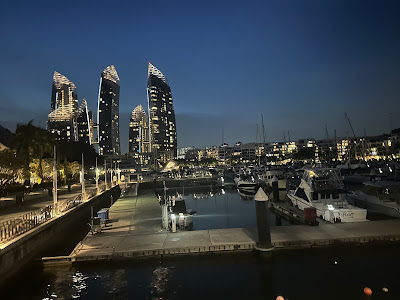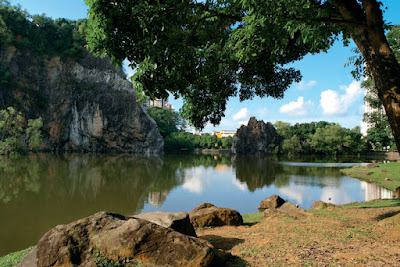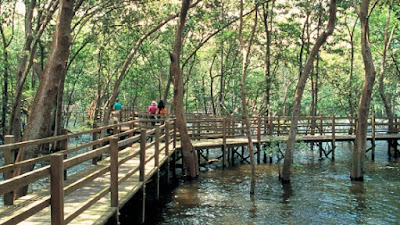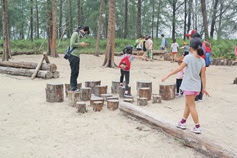5 Hidden Gems in Singapore you cant miss
Singapore is a bustling country, with lots of good food and the good vibes of a city life. However, there is much more to explore, other than visiting the Merlion or shopping along Orchard Road
Below are 5 places that offers you a glimpse of a different side of this little merlion city!
1) Keppel bay
Keppel bay is suitable for viewing sunsets , enjoying a romantic stroll with your family or just soaking in the serene atmosphere.
There are a few pavilions that offers shade from the sun , with seats for resting. Marina at keppel bay is situated at the island so you might spot the occasional yachts or boats sailing out to the sea.
There are also a few restaurants there which are suitable for a nice breakfast or dinner date while enjoying views of the marina or the ocean.
Opening hours : 0600 hrs - 0000 hrs daily
Directions : Travel to Harbourfront MRT (NE1 / CC29) , exit via Harbourfront Centre and walk westwards for around 7 mins. You should pass by Bank of America building. Turn in at Keppel bay drive and walk towards Keppel Bay bridge. Cross the bridge to reach the island
2) Little Guilin
This nature park is located in the western part of Singapore, in Bukit Batok, which covers the subzone Bukit Gombak.
Back in the past, the area used to be a granite quarry before being transformed into a nature park. The name of Bukit Batok literally translates into "coughing hills" in Malay, which came about as the sounds from quarrying activities could be heard radiating into the distance. The granite quarry in this area was used to extract Gombak norite, a material that could be used in concrete, walls and roads.
Because of its past as a granite quarry, the park bear a striking resemblance to the granite rock formations in Guilin, China. This is how its name "Little Guilin" came about.
Enjoy the view of the tranquil lake against the magnificent backdrop of the towering granite rock formations. Walk along the banks of the lake through the beautiful landscape of the park. Occasionally, you may spot people engaging in nature photography or couples having their wedding photoshoot by the lake.
Opening hours : 24 hours
Directions : Take bus 945 and alight at Bukit Gombak Stadium or take MRT to Bukit Gombak MRT and walk about 5 mins. The park is located next to Bukit Gombak stadium
3) Kampong Lorong Buangkok
Kampong Lorong Buangkok
Kampong Lorong Buangkok is the last place on Singapore island that show resemblance of life in the early 1900s. Back then, many residents live in wooden houses in a closely clustered village also termed as "kampong".
Residents in a kampong have close ties to their neighbours as they often host each other for dinner and help each other out.
Kampong lorong buangkok was built in 1956 by a businessman called Mr Sng, with a purpose for housing plantation workers. When he passed away, his youngest daughter Mdm Sng inherited the land and still lives in the kampong today.
Entering the kampong, you are greeted by the sound of chickens. Chickens roam freely around the kampong and are kept as pets by the residents. There are many types of plants growing in the areas around the kampong which could be used for various purposes. The breadfruit looks like a mini version of jackfruit and could be used for making yummy chips while the citronella has mosquito repellent properties.
The kampong offers a look into the history of Singapore while still remaining functional as a housing in modern times. This is truly a case of "past-meets-present"
Fun fact: Currently, around 25 families live in the kampong and pays monthly rental of $4- $30
Photos by Singapore Tourism Board
First opened in 1993, sungei buloh wetland reserve has since expanded to over 200 ha, consisting of mangroves , mudflats, forests and ponds. It has also been included under the East Asian Australasian Shorebird Site Network, which also includes Kakadu National Park in Australia, Yatsu Tidal flats in Japan and Mai Po- Inner deep bay in China.
Make a visit to this nature reserve and trek through the various walking trails while discovering the wide range of wildlife inhabitants living there. You could spot crabs, shellfish, giant mudskippers , monitor lizards, spiders, otters and birds. Kingfishers, herons and sunbirds are among the resident birds in the nature reserve. During the migratory season from August to April, bird watchers and photographers frequent the park to catch sightings of migratory birds from as far as Siberia, making a pitstop here before continuing their journey to Australia.Take a break from the bustling city life and head to this ecological gem to indulge in nature's serenity.
Fun fact: You could occasionally sight a crocodile in the waters while walking along the broadwalk. It is safe as long as you stay on the main walking path.
5) Coney Island
Photos by NParks
Coney island is located in the northeastern part of Singapore, sitting with the town of Punggol. The land was once privately owned by 2 entrepreneur brothers who introduced the product "Tiger Balm", still sold to this day.
The island was then sold to an Indian businessman who had grand plans to develop it into an island amusement park, modelling after the popular New York destination of the same name. The plans did not come to fruition and the land was eventually slated for government redevelopment. The island was subsequently expanded through land reclamation and in 2015, Coney island park was opened to the public. There is a 2.4km path through the park as well as a beach spanning 2km.
Embark on a relaxed, long stroll around the park or cycle along the Park Connector which spans through Coney island while enjoying the beautiful promenade view of Serangoon Reservoir. You can also choose to spend some quiet time at the beach. Alternatively,
spend some time at Casuarina Exploration where the surrounding features such as broadwalk, seats , benches and exhibits are made from uprooted Casuarina trees. The recycling of timber from uprooted Casuarina trees is part of an environment initiative toallow Coney island park to be ecologically sustainable.
Fun fact : A Brahman cow used to live in solitary on the island, and it remains a mystery of how it ended up there.
Kampong Lorong Buangkok is the last place on Singapore island that show resemblance of life in the early 1900s. Back then, many residents live in wooden houses in a closely clustered village also termed as "kampong".
Residents in a kampong have close ties to their neighbours as they often host each other for dinner and help each other out.
Kampong lorong buangkok was built in 1956 by a businessman called Mr Sng, with a purpose for housing plantation workers. When he passed away, his youngest daughter Mdm Sng inherited the land and still lives in the kampong today.
Entering the kampong, you are greeted by the sound of chickens. Chickens roam freely around the kampong and are kept as pets by the residents. There are many types of plants growing in the areas around the kampong which could be used for various purposes. The breadfruit looks like a mini version of jackfruit and could be used for making yummy chips while the citronella has mosquito repellent properties.
The kampong offers a look into the history of Singapore while still remaining functional as a housing in modern times. This is truly a case of "past-meets-present"
Fun fact: Currently, around 25 families live in the kampong and pays monthly rental of $4- $30
Opening hours : 0900 hrs - 2000 hrs (recommended) as there are residents living in this area
Directions : Travel to Buangkok MRT (NE15) , and take bus 114. The bus goes in a small loop , starting and ending at Buangkok MRT. Alight at Buangkok Sports Park and take a short 5 mins walk along Lor Buangkok to reach the place.
4) Sungei Buloh Wetland Reserve
Directions : Travel to Buangkok MRT (NE15) , and take bus 114. The bus goes in a small loop , starting and ending at Buangkok MRT. Alight at Buangkok Sports Park and take a short 5 mins walk along Lor Buangkok to reach the place.
4) Sungei Buloh Wetland Reserve
Photos by Singapore Tourism Board
First opened in 1993, sungei buloh wetland reserve has since expanded to over 200 ha, consisting of mangroves , mudflats, forests and ponds. It has also been included under the East Asian Australasian Shorebird Site Network, which also includes Kakadu National Park in Australia, Yatsu Tidal flats in Japan and Mai Po- Inner deep bay in China.
Make a visit to this nature reserve and trek through the various walking trails while discovering the wide range of wildlife inhabitants living there. You could spot crabs, shellfish, giant mudskippers , monitor lizards, spiders, otters and birds. Kingfishers, herons and sunbirds are among the resident birds in the nature reserve. During the migratory season from August to April, bird watchers and photographers frequent the park to catch sightings of migratory birds from as far as Siberia, making a pitstop here before continuing their journey to Australia.Take a break from the bustling city life and head to this ecological gem to indulge in nature's serenity.
Fun fact: You could occasionally sight a crocodile in the waters while walking along the broadwalk. It is safe as long as you stay on the main walking path.
Opening hours : 0700 hrs - 1900 hrs. Last entry at 1830 hrs
Directions :
Directions :
Mon to Sat - Travel to Kranji MRT (NS7) , and take bus 925. Alight at Kranji Reservoir Park B and cross over to the vistor centre
Sun & Public Holiday - Travel to Woodlands MRT (NS9 / TE2) and take bus 925M. Alight at the bus stop "Sg Buloh Wetland Reserve" which is at the Wetland Centre entrance
5) Coney Island
Photos by NParks
Coney island is located in the northeastern part of Singapore, sitting with the town of Punggol. The land was once privately owned by 2 entrepreneur brothers who introduced the product "Tiger Balm", still sold to this day.
The island was then sold to an Indian businessman who had grand plans to develop it into an island amusement park, modelling after the popular New York destination of the same name. The plans did not come to fruition and the land was eventually slated for government redevelopment. The island was subsequently expanded through land reclamation and in 2015, Coney island park was opened to the public. There is a 2.4km path through the park as well as a beach spanning 2km.
Embark on a relaxed, long stroll around the park or cycle along the Park Connector which spans through Coney island while enjoying the beautiful promenade view of Serangoon Reservoir. You can also choose to spend some quiet time at the beach. Alternatively,
spend some time at Casuarina Exploration where the surrounding features such as broadwalk, seats , benches and exhibits are made from uprooted Casuarina trees. The recycling of timber from uprooted Casuarina trees is part of an environment initiative toallow Coney island park to be ecologically sustainable.
Fun fact : A Brahman cow used to live in solitary on the island, and it remains a mystery of how it ended up there.
Opening hours : 0700 hrs - 1900 hrs. (Gates will be closed at 1900)
Directions :
Directions :
Travel to Punggol MRT (NE17) , and walk to punggol bus interchange which is beside the MRT. Take bus 84 and alight at Punggol settlement. Walk 500m eastwards along the Punggol Promenade Nature Walk to get to Coney Island West Entrance.












Interesting blog on Singapore
ReplyDeleteThank you for your kind comments! There are many wonderful under-the-radar places in Singapore that I hope to share through this blog and inspire more people to explore them
Delete